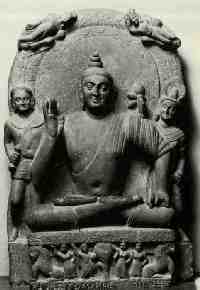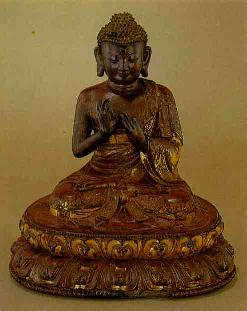INTERPRETING THE LIFE
OF HISTORICAL BUDDHA
Having learned about the history of Shakyamuni Buddha who lived in this world
2500 years ago, we have to consider why Buddhists believe in him and
why Buddhists follow his teachings and ways of life. It is a very
important question for all Buddhists, and for those who are interested
in Buddhism.
No doubt that Shakyamuni Buddha was a historical man, not a mythical figure, who introduced Buddhism known today. Never had the
Buddha claimed that he was the son or a messenger of God. The Buddha was a unique human being who was self-enlightened.
He practised to perfection through his own effort. He discovered and revealed the supreme and ultimate universal truths
through his mental purification.
The life history of Shakyamuni Buddha is the foundation of Buddhism. It is the model life for all of us to follow in
attaining Buddhahood.
33.1 A youth of enormous will power
 The renunciation of Shakyamuni Buddha is unprecedented in history.
He left at the height of youth, from pleasures to difficulties; from
certainty of material security to uncertainty; from a position of
wealth and power to that ofi wandering ascetic who took shelter in
the cave and forest. He renounced his position, wealth, promise of
prestige and power, and a life filled with love and hope, in exchange
for the search for Truth which no one had found. His renunciation
was the boldest step that a man has ever taken.
The renunciation of Shakyamuni Buddha is unprecedented in history.
He left at the height of youth, from pleasures to difficulties; from
certainty of material security to uncertainty; from a position of
wealth and power to that ofi wandering ascetic who took shelter in
the cave and forest. He renounced his position, wealth, promise of
prestige and power, and a life filled with love and hope, in exchange
for the search for Truth which no one had found. His renunciation
was the boldest step that a man has ever taken.
33.2 An earnest seeker of truth
For first six years, he laboured to find the Truth. He studied under the foremost masters of the day, and learned all that
these religious teachers could teach him. When he could not find what he was looking for, he joined a group of ascetics
and tortured his body so as to break its power and crush its interference, since it was believed that Truth could be found
this way. As a man of enormous energy and will power he outdid other ascetics in every austerity they proposed. He pushed
himself to the extent that no man had done and yet lived. He, too, would have certainly died had he not realized the
futility of self mortification, and decided to practise moderation instead.
On the full moon night, he sat under the Bodhi tree and went into deep meditation.
It was then that his mind burst ithrough the bubble of the universe
and realized the true nature of all life and all things. At the age
of 35, he was transformed from an earnest truth seeker into the Buddha,
the Enlightened One.
33.3 A revolutionary for freedom and
equality
For nearly half a century, the Buddha walked on the dusty paths
of India teaching the Dharma so that those who heard and practised
could be ennobled and free. He founded an order of monks and nuns,
challenged the Four Caste system, raised the status of women, taught
religious freedom and free inquiry, opened the gates of deliverance
to all. Without any class discrimination, Shakyamuni treated all his
followers impartially, regardless of their race, caste, class or economic
status.
He taught the people how to eradicate ignorance. He encouraged them to maintain freedom in the mind to think freely.
Rigid rituals, rigid dogmas, blind faith and the caste system, all had no place in his way of life. All people were considered
to be equal in the views of the Buddha.
33.4 A great teacher of all people
 During his active life as a teacher, the Buddha enlightened many who
listened to him. He went in search of the vicious to teach, while
the pure and virtuous came in search of him to learn. To all, he gave
the gift of the Truth that he had discovered. His disciples include
kings and soldiers, merchants and millionaires, beggars and courtesans,
religious as well as deluded people.
During his active life as a teacher, the Buddha enlightened many who
listened to him. He went in search of the vicious to teach, while
the pure and virtuous came in search of him to learn. To all, he gave
the gift of the Truth that he had discovered. His disciples include
kings and soldiers, merchants and millionaires, beggars and courtesans,
religious as well as deluded people.
The Buddha was a practical teacher, full of compassion and wisdom,
knowing how and what to teach each individual for the individual's
own benefit and according to the individual's level of need and capability
to comprehend. A great Buddhist philosopher Nagarjuna summarized Shakyamuni's
teaching methods in four catagories:
- according to the needs of the audience.
- according to the intellectual capacities of the audience.
- teaching by refuting and correcting the vices and errors of the audience.
- teaching the ultimate truth when the audience had advanced to the point where they were capable of comprehending it.
Through his mental purification, he opened the doors to all knowledge, He knew all things to be known, cultivated all things
to be cultivated, and destroyed all things to be destroyed. Indeed, no other religious teacher was comparable to him ini
terms of cultivation and attainment. Even today this great teacher is honoured not only by the religious-minded people;
he is also honoured by atheists, historians, rationalists and intellectuals all over the world who have acknowledged him
as the Enlightened, most liberally minded and compassionate teacher.
33.5 A great thinker with supreme
wisdom
He was a man of wisdom and intellect. Every problem was analysed in component
parts and then reassembled in logical order with the meaning made
clear. None could defeat him in debate. As an unequalled teacher,
he still is the foremost analyst of the mind and phenomena even up
to the present day. For the first time in history, He gave men the
poweri to think for themselves, raised the worth of mankind, and showed
that man can reach the highest knowledge and supreme Enlightenment
by his own efforts.
Having a full and complete understanding of Dharma, i.e. the reality of the nature of all phenomena throughi
enlightenment, Shakyamuni Buddha knew the causes of suffering and the ways to cease suffering andi
to attain ultimate happiness.
33.6 A man with kindness and
compassion
 There was never an occasion when the Buddha expressed any unfriendliness
towards a single person. Not even to his opponents and worst enemies
did the Buddha express any unfriendliness. There were a few prejudiced
mindsi who turned against the Buddha and who tried to kill him; yet
the Buddha never treated them as enemies.
There was never an occasion when the Buddha expressed any unfriendliness
towards a single person. Not even to his opponents and worst enemies
did the Buddha express any unfriendliness. There were a few prejudiced
mindsi who turned against the Buddha and who tried to kill him; yet
the Buddha never treated them as enemies.
There were great philosophers and thinkers, who lacked the inspiring love for the suffering multitude. As a religious leader,
Shakyamuni was so filled with such all-absorbing sympathy and love for suffering humanity as ever in the history of
the world. The Buddha's way of saving mankind is to teach them how to find salvation through their own effort.
None is rejected nor discriminated. It is because of compassion that he was not interested in alleviating the physical
or mental distress, but in getting rid of suffering and disease, decay and death, and all the worries and miseries of
living beings. He was more concerned to reveal an ultimate way that all people could follow.
Let's take all the great philosophers, psychologists, great thinkers, scientists, rationalists, social workers,
reformers and other religious teachers and compare, with an unbiased mind, their greatness, virtues, services and wisdom
with the Buddha's virtues, compassion and Enlightenment. One can understand where the Buddha, a man 2500 years ago, stands
amongst all those great people.
It is interesting to note that the Buddha was the first religious leader in
human history to admonish against animal sacrifice for any reason.
His great compassion extends to all living beings in the Ten Realms.
33.7 A religious founder beyond
religion
After the First Sermon and the ordination of the Five Bhiksus, the
monastic order in Buddhism i.e. Sangha Order was established by Shakyamuni.i
Thus, the three essential elements of Buddhism known as The Three
Jewels ori Triratna came into existence:
- the Buddha - Shakyamuni himself,
- the Dharma - the Four Noble Truths etc.
- the Sangha - the Five Bhiksus.
As a founder of Buddhism, Shakyamuni expounded his discoveries and doctrine and enlightened others by indicating
the path and method whereby he delivered himself from suffering and death, and achieved his ultimate goal,
and by cultivating for the wellness, benefit and happiness of all beings.
It is importance to note that the Buddha exhorts his followers to depend on themselves for their deliverance,
since both defilement and purity depend on oneself. One cannot directly purify or defile another. The Buddha was only a teacher.
The Buddha was a human being. As a man he was born, as a Buddha he lived, and as a Buddha, his life came to an end.
Though human, he became an extraordinary man owing to his unique characteristics. The Buddha emphasized on this important point,
and left no room for anyone to fall into the error of thinking that he was an immortal being.
Buddhism is too vast and too profound to be simply placed in any single category, such as a philosophy,
a religion and a way of life. Buddhism is all embracing, beyond these categories. Different people living at different times and in different places have given different labels and interpretations to Buddhism. In a nutshell, Buddhism is Noble Truth.
Shakyamuni Buddha is the greatest conqueror the world has ever seen. His teaching illuminates the way for the mankind to cross from a world of darkness, hatred and suffering to a new world of light, love and happiness.




